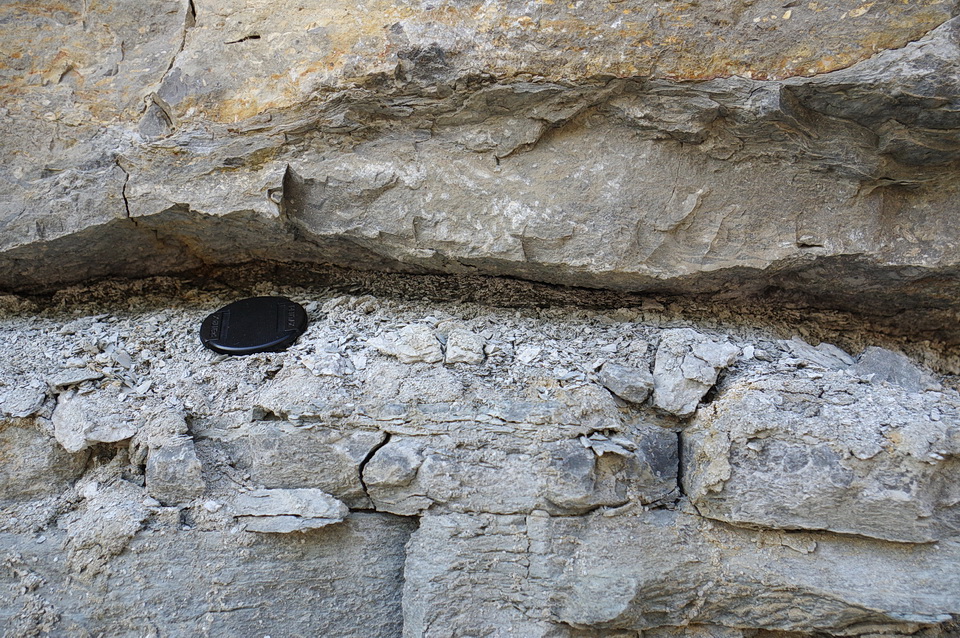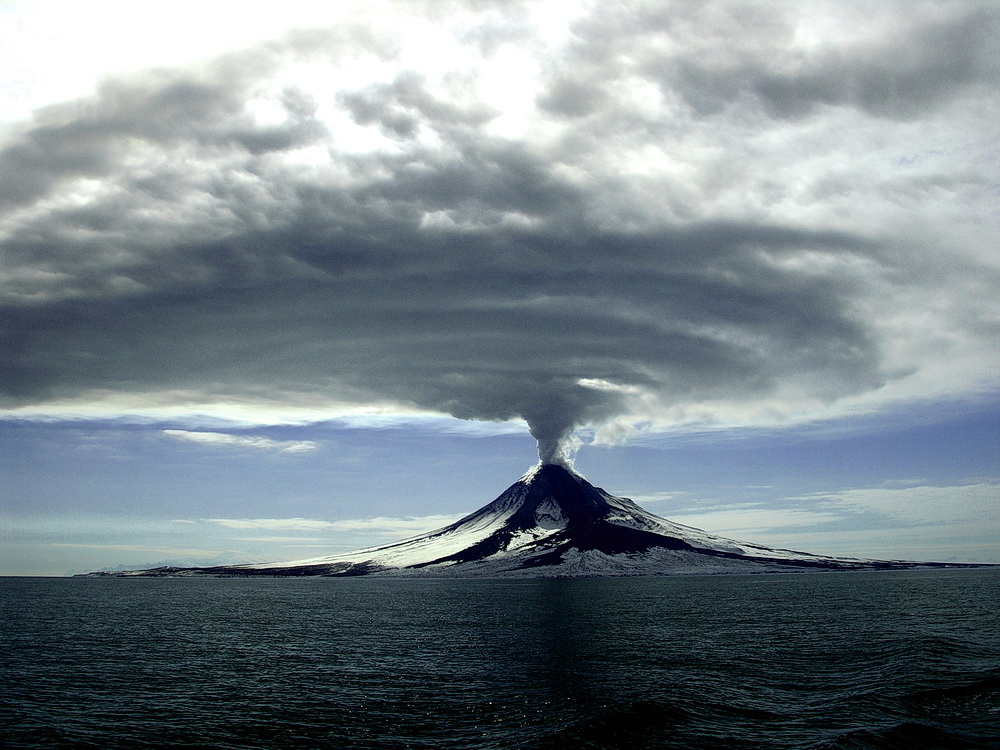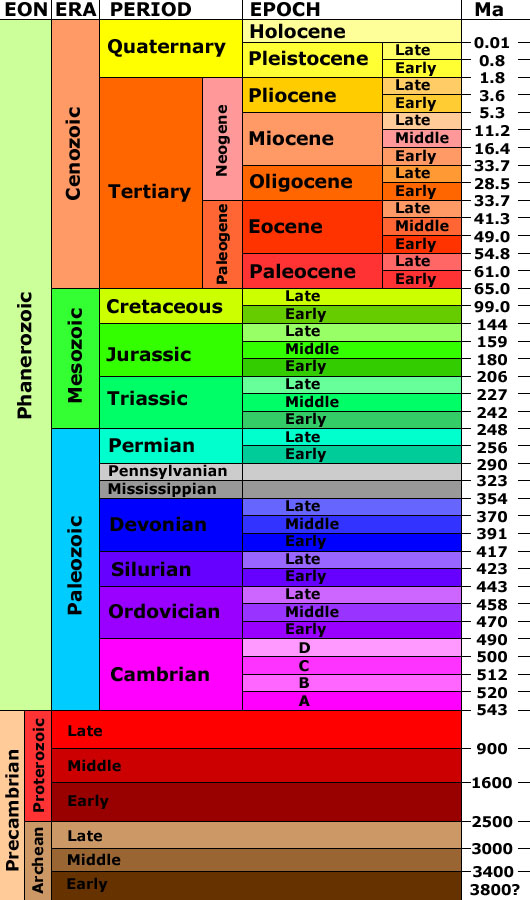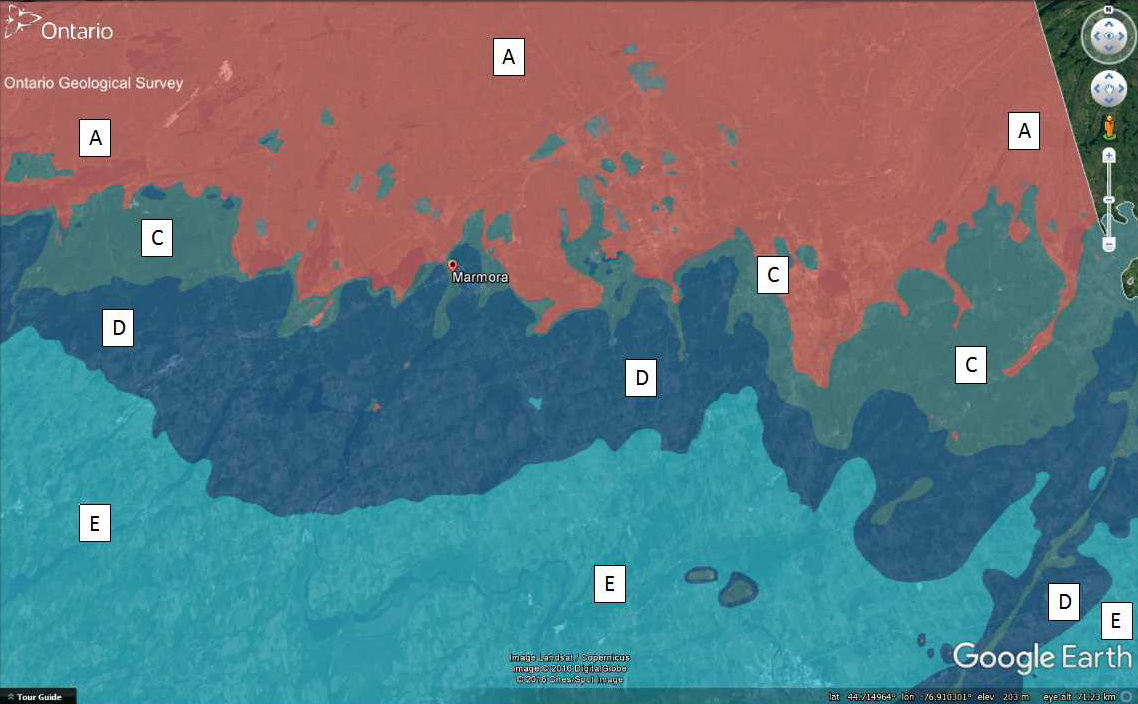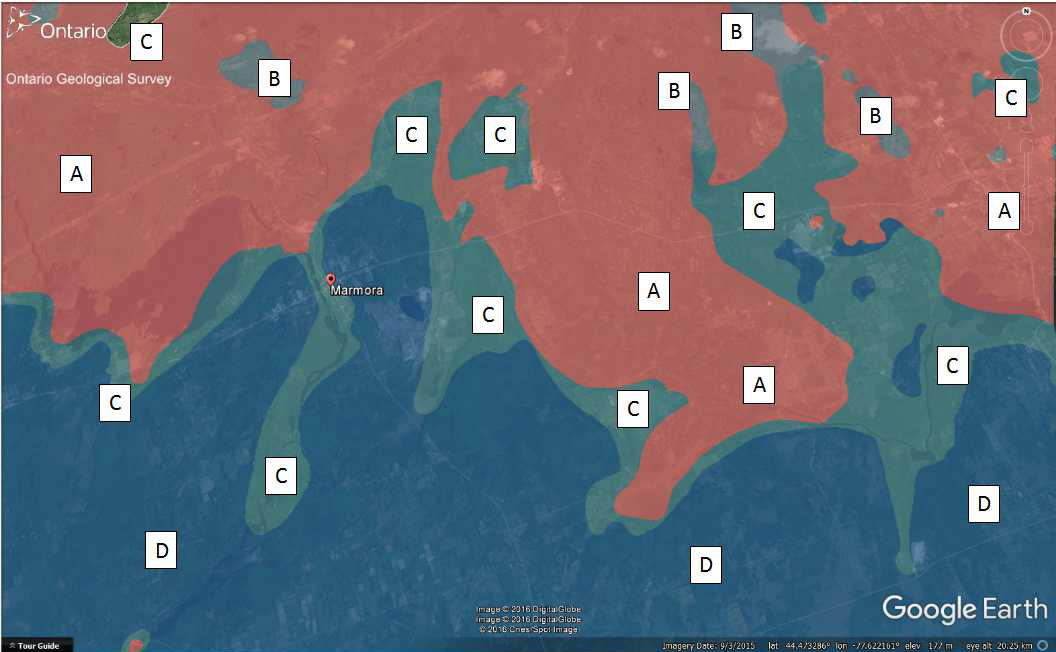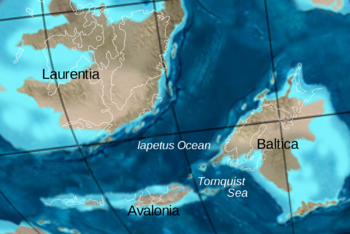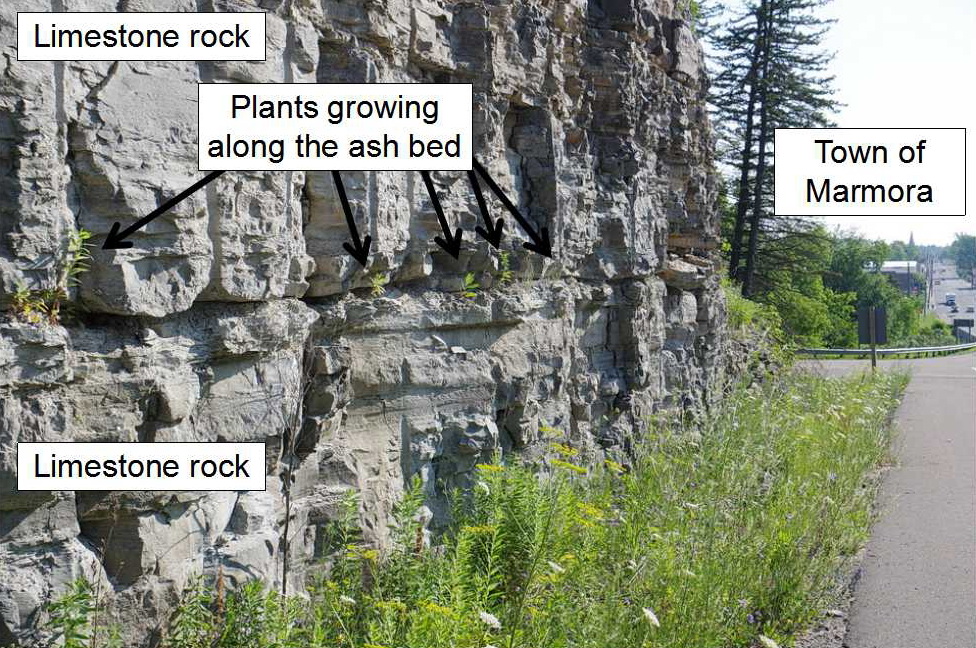Ontario: The Geological Story of the Marmora Volcanic Ash Beds
Figure 1: Old, weathered volcanic ash beds are exposed in the rock cut on the west side of Marmora. The weathered volcanic ash beds occur in the road cut consisting of grey-coloured Ordovician limestone. The weathered volcanic ash beds, marked by the camera lens cap, are thin, recessively-weathering, soft, crumbly, and grey-coloured. Photo by Andy Fyon, July 7, 2016.
Gigantic Volcanoes Left Their Calling Cards In Ontario
If you have the opportunity to drive along Highway 7, through the town of Marmora (see location map above), stop to look at the limestone rock cut, on the north side of the hill, just to the west of the town of Marmora. Here you see several layers, up to 20 cm thick, of ancient volcanic ash (Figure 1) layered within the limestone.
These layers of volcanic ash tell a story of very large volcanic eruptions that took place about 450 million years ago. The volcanoes that erupted were in the ocean, off the east coast of North America.
The volcanoes blasted the volcanic ash, high into the atmosphere. The volcanic ash fell onto the surrounding ocean and the land where it accumulated as sedimentary layers called beds. The volcanic ash beds are preserved within limy rock, called limestone, which also accumulated on the floor of an ancient tropical ocean that covered part of the land we now call Ontario.
What Do The Marmora Ash Beds Look Like?
The Marmora ash beds are light grey in colour (Figure 1 and 2). Based on colour alone, the volcanic ash beds are hard to distinguish from the light grey-coloured limestone rock in the road cut (Figure 2); however, the volcanic ash beds are distinctive because they are much softer than the limestone rock. You can scrape out pieces of the ash layer using your fingers.
Figure 2: Close-up view of the grey-coloured, weathered, volcanic ash bed in the limestone rock. Note the soft nature of the volcanic ash bed, which weathers recessively into the enclosing, hard, limestone rock of the Bobcaygeon Formation. A plant has set roots in the bed of the soft weathered volcanic ash bed. Photo by Andy Fyon, July 7, 2016.
The Marmora ash beds have changed over time from their original state. The ash beds now consist of clay minerals. Work by Derek Armstrong of the Ontario Geological Survey shows that the clays are mixed layer illite--smectite clays in ratios ranging from 70/30 to 85/15, with minor amounts of the minerals zircon, quartz, pyrite, calcite, and feldspar. The presence of the clay minerals is the result of chemical weathering of the original ash material.
What Is Volcanic Ash?
Volcanic ash is made of broken rock fragments, minerals, mineral fragments, solidified magma droplets, and other volcanic material that was shattered, broken, and blasted high into the air when a volcano erupts explosively. Volcanic ash grains are small - less than 2 mm in diameter.
One type of violent volcanic eruption occurs when gases, like water (H2O) and carbon dioxide (CO2), which are dissolved in the melted rock called magma, expand and escape violently from the magma into the atmosphere (Figure 3). Magma is created deeper in the Earth when a rock starts to melt. The gases dissolved in the magma escape when the magma gets close to the surface of the Earth. The rapid and violent escape of the dissolved gas is like the escape of carbon dioxide gas when you quickly open a bottle or can of warm, carbonated soft drink or pop!
The violent escape of gas from the magma blows the volcanic material into very small pieces. Those pieces are blown high into the atmosphere. The liquid magma droplets cool quickly and become solid. All of this ash material falls down to the Earth's surface. This type of violent eruption can last for hours or days, periodically blowing volcanic ash into the air. The winds can carry the material thousands of kilometers away from the volcano (Figure 3).
Figure 3: An example of a violent volcanic eruption. This is the Augustine volcanic eruption, 2006. The Augustine Volcano is historically the most active volcano in Alaska’s Cook Inlet region. The eruption started on January 11, 2006, and lasted until mid-March of 2006. The cloud above the volcano is mostly volcanic ash. Old ash deposits from this volcano were carried by the winds as far as 3000 km away. Photo By Cyrus Read, U.S. Geological Survey [Public domain or CC0], via Wikimedia Commons.
Geological Time - A short Discussion
Geologists subdivide the Earth's history into blocks of time (Figure 4). Geological time for Earth began about 4.54 billion years ago, when the Earth was created. The time subdivisions are based on several factors, including actual age dates of rocks, differences in rock types, differences in fossil types, and major geological events that are recognizable in the rock record.
Figure 4: A simplified time chronology of geologic time for the Earth. Rocks in the Marmora area are assigned to the Precambrian Eon and the Paleozoic Era. The Marmora volcanic ash occurs as layers within limestone rock of the Ordovician Period.
The rocks that contain the Marmora volcanic ash are part of a package of rock that was created between 490 million years ago and ended about 445 million years ago, during a time period named the Ordovician Period (Figure 4).
Regional Geology Of Marmora Area
Geologists use coloured maps to show the geology of an area. Each colour is standardized and corresponds to a particular geological feature or rock type (Figure 5).
The rock geology of the Marmora region is subdivided into 2 very different packages. The oldest package consists of very old rock called Precambrian Shield granite rock (Unit "A"; Figure 5) that formed more than 1 billion years ago. A younger package of limy rock (Units "C", "D", and "E", Figure 5) formed in a warm tropical ocean between about 490 and 445 million years ago. The younger rock units formed during a geological time called the Paleozoic Era. The younger, Paleozoic, limy rocks (Units "C", "D", and "E", Figure 5) lie like a blanket on top of the very old Precambrian Shield rock (Unit "A"; Figure 5).
Figure 5: The regional bedrock geology map of the Marmora area. The colour explanation: A = old Precambrian Shield granite rocks. Paleozoic rocks consist of: B = Shadow Lake Formation (too small to see at this scale, so it is not shown on the bedrock geology map); C = Gull River Formation (part of Simcoe Group, limy rocks called limestone, dolostone); D = Bobcaygeon Formation (part of Simcoe Group, limy rock called limestone, with minor shales in upper part), E = Verulam Formation (part of Simcoe Group, limy rock called limestone and shale rock). Geology from OGS Earth, Paleozoic Bedrock Geology of Southern Ontario.
Details Of The Younger Rock Geology Of The Marmora Area
The younger rocks of the Marmora area formed during the Paleozoic Era. The Paleozoic Era lasted a long time - from 541 to 252 million years ago. Within the Paleozoic Era, shorter time divisions have been identified. Different rock types formed during these different, shorter time divisions because the geological conditions changed over time. Differences used to identify these shorter time divisions include different rock types, different fossil types preserved within the rocks, differences in the form of similar fossils of marine animals and plants, and by measuring the actual age of the rocks.
Ordovician Period
One of the shorter time divisions of the Paleozoic Era is called the Ordovician Period. The Ordovician Period started about 490 million years ago and ended about 445 million years ago. During the Ordovician Period, limy material, consisting of muds and dead marine animals, accumulated on the bottom of the tropical ocean that covered part of the land we now call Ontario.
In the Marmora area, rock units "B", "C", and "D" (Figure 6) formed during the Ordovician Period.
Figure 6: The local bedrock geology around the town of Marmora. The explanation is as follows: A (red) = old Precambrian Shield granite rocks; Paleozoic Rock: B = Shadow Lake Formation (part of the Simcoe Group; red, maroon and green coloured sandstones and conglomerates, shales, and siltstones and minor amounts of limy and clay-bearing dolomites and limestones) which lie on top of the Precambrian granite rock; C = Gull River Formation (part of Simcoe Group; limy rocks called limestone, dolostone); and D = Bobcaygeon formation (part of Simcoe Group, limy rock called limestone, with minor shales in upper part, Marmora ash). Geology from OGS Earth, Paleozoic Bedrock Geology of Southern Ontario.
The Ordovician Period is further subdivided into even smaller time periods, based on differences between the rock types and the fossils they contain. Geologists have assigned the name Bobcaygeon Formation (Unit "D", Figure 5 and 6) to the rocks in the road cut just west of the town of Marmora . The Marmora ash beds occur as layers within the limestone rocks of the Bobcaygeon Formation (Unit "D", Figure 6).
The Bobcaygeon Formation limestone rock (Figure 7) began as limy material that accumulated on the bottom of an ancient tropical ocean. When a volcanic eruption occurred and produced volcanic ash, that ash also fell onto the bottom of the tropical ocean, where it was preserved as a distinct layer in the limy mud. The limy material, with the layers of volcanic ash, was buried, heated and squeezed by the weight of overlying deposits. This changed the limy material into limestone rock.
Figure 7: The grey, limestone rock of the Bobcaygeon Formation occurs in a rock cut, on the north side of Highway 7, immediately west of the town of Marmora. The town of Marmora is seen at the foot of the hill. These limestone rocks contain the weathered, Marmora volcanic ash beds. Photo by Andy Fyon, July 7, 2016.
"What A Blast!"
Geologists call the ash beds "K-bentonite" layers. The letter "K" mean potassium and the word "bentonite" refers to a type of clay mineral. The weathered, Marmora volcanic ash beds are not unique in Ontario, or for that matter, the eastern United States. The Ontario K-bentonite layers are the same as similar weathered volcanic ash deposits in eastern North America (Deicke and Millbrig K-bentonite ash beds), and similar weathered volcanic ash beds found in western Europe (Figure 8). The black and grey coloured areas (Figure 8) show the distribution of the weathered volcanic ash beds in eastern North America and western Europe.
Figure 8: The approximate location of the continents about 450 million years ago is illustrated in this image. The black and grey coloured areas represent the distribution of the weathered volcanic ash beds in eastern North American and western Europe.This image gives us an indication of the explosive volcanic eruptions that were responsible for the ash beds. Note that the size, shape and location of the continents at this time, 450 million years ago, is different from today because of the geological process of continental drift. Image from Kyoungwon, Renne, and Huff.
The shape and location of the continents may look a bit odd in Figure 8 because the figure shows the shape and location of the continents as they existed about 450 million years ago. The geological process called continental drift, which is part of plate tectonics, is responsible for moving the continents around over geological time.
How Old Are The Marmora Ash Beds?
The Marmora volcanic ash beds occur as layers in the Ordovician limestone. Therefore, the ash beds, and the volcanic eruptions that created them, took place between about 485 and 445 million years ago. But, geologists have actually measured very precisely the age of the ash material. Technical staff at the Royal Ontario Museum, working with Derek Armstrong, Ontario Geological Survey, determined that one weathered ash bed located to the west of the Marmora area was 452.6 +/- 0.8 million years old. This age of this ash is similar to ages measured by Kyoungwon, Renne, and Huff for the three thickest and most widespread volcanic ash deposits in North America (Deicke and Millbrig ash) and Sweden and Denmark (Kinnekulle ash).
Therefore, we can say with confidence that these volcanic ash deposits, including the Marmora volcanic ash bed, formed about 452 million years ago.
What Geological Process Created The Volcanoes That Created The Marmora Ash Beds?
Large volcanic eruptions created the Marmora ash beds. But what geological processes created the volcanoes? To answer that question, we have to understand what was happening on the Earth about between 600 and 450 million years ago.
Note that the history that led to the creation and eruption of the volcanoes was complex and I have greatly simplified the story. In simplifying, technical experts will find omissions, some great generalities, and some comments that appear to be wrong because the complex geological context is missing.
The sequence of events that led to the eruption of large volcanoes started about 600 million years ago, when an ancient continent broke up. A fragment of continent called Laurentia was created - the ancestor of North America (Figure 9). Also created was a new ocean named the Iapetus Ocean - the ancestor of the Atlantic ocean (Figure 9). The process of pushing the Iapetus Ocean floor down beneath another piece of oceanic crust is called subduction. The zone along which one piece of the oceanic crust is pushed down under another piece of crust is called a subduction zone (Figure 11). Subduction was an important process that created the magma needed to create and sustain the ocean island volcanoes.
Figure 9: The Iapetus Ocean is the ancestor to the Atlantic Ocean. It formed when continents began to break apart and drift around due to continental drift. The Continent named Laurentia was the ancestor to North America. The Iapetus Ocean closed up as the Baltica and Avalonia microcontinents and the Taconic Volcanic Island Arc islands drifted northward to collide with Laurasia.
The new Iapetus ocean continued to widen, but about 550 to 500 million years ago, one part of the Iapetus oceanic crust, located to the east of Laurentia, was pushed down beneath another piece of oceanic crust (Figure 10). The process of pushing the Iapetus Ocean floor down along the subduction zone is called subduction. The zone along which one piece of the oceanic crust is pushed down under another piece of crust is called a subduction zone (Figure 10). The subducted oceanic crust got hotter and started to melt deep in the Earth to create magma. Magma created by the melting oceanic crust rose to the surface to create a string of large volcanoes called a volcanic arc (Figure 10). The volcanic arc volcanoes received a supply of magma from the melting, subducted oceanic crust and remained active from about 545 million years ago to 450 million years ago (Figure 10).
Figure 10: A cartoon that illustrates part of the history of the Taconic Orogeny, which ended about 440 Million years ago. During the Taconic Orogeny, the ancestral Atlantic Ocean and the Appalachian Mountains were created along the east coast of North America, were created. The Marmora ash beds were created by the huge eruption of one or more volcanoes, which occurred in a volcanic island arc, about 450 million years ago.. The image is public domain, from the United States Geological Survey.
By about 490 to 445 million years ago, continental drift moved Laurentia from the southern hemisphere into the sub-tropical latitudes, closer to the equator. Because Laurentia sat in a warm tropical sea, limy muds formed on the floor of the shallow Iapetus Ocean, close to the coast line of Laurentia. Those muds became the Ordovician limestone rock that we see on the side of Highway 7, outside of the town of Marmora. Those are the limestone rocks that contain the Marmora volcanic ash beds.
The subduction and melting of the Iapetus oceanic crust could not go on for ever. The subduction process consumed the Iapetus oceanic crust. This ultimately led to the closing of the Iapetus Ocean by about 430 million years ago.
Many other geological events took place between 600 million years ago and 430 million years ago, including the collision and plastering of volcanic islands and microcontinents onto the east coast of Laurentia (Figure 10). This collision started the process of creating a mountains along the east coast of Laurentia. These mountains were the ancestors of the Appalachian Mountains.
About 452 million years ago, one or more of the large volcanic arc volcanoes located to the east of Laurentia, erupted violently about 450 million years ago. The ash created by these enormous volcanic eruptions not only became the Marmora ash deposit, but also was the source of ash that fell across eastern Laurentia and western Europe. Recall, the subduction of Iapetus ocean floor created the magma that fed volcanoes.
These geological processes that involved volcanic eruptions, and the collision of Laurentia with volcanic arcs, were part of an event called the Taconic Orogeny. Geologists use the word "orogeny" to describe the geological processes that deform large parts of the upper parts of the Earth's crust and uppermost mantle.
Marmora Ash Beds And Plants
The weathered, clay-rich Marmora volcanic ash beds contain a lot more chemical nutrients needed by plants, compared to the limestone rock. Also, the clay material acts a bit like a sponge and retains groundwater, compared to massive limestone rock. For these reasons, plants often take root in the ash beds that are exposed along the face of the road cut. Take a close look at the rock cut. Chances are where you see a line of plants, you are also looking at a layer of soft, weathered Marmora volcanic ash (Figure 11).
Figure 11: An example of one bed of Marmora ash in the centre of the photo. The black arrows point to a line of plants that prefer to grow in the weathered volcanic ash bed because the ash contains more nutrients, water, and is softer for the roots. Photo by Andy Fyon, July 7, 2016.
Summary
The Marmora volcanic ash beds lie within Ordovician limestone rock, located immediately west of the town of Marmora.
The ash beds formed about 450 million years ago when volcanoes, in a volcanic arc that formed above subducted ocean crust that floored the Iapetus ocean. The volcanic arc lay off the east coast of what we now call North America. The volcanoes were created when Iapetus ocean crust was subducted, heated deep in the Earth, melted, and the magma rose to the surface where it erupted to form a volcano. The subduction of the Iapetus ocean crust ultimately let to the consumption and closure of the Iapetus Ocean. These complex geological events, including the building of mountains along the east edge of Laurentia - the ancestor of North America - culminated in the major geological event called the Taconic Orogeny.
The Taconic Orogeny had several impacts on the land we now call Ontario. One impact was the deposition of the Marmora Volcanic ash deposit, and similar deposits elsewhere in Ontario, eastern North America, and western Europe, at about 450 million years ago. The geological evidence suggests that the volcanic eruptions that created the Marmora ash, and its related deposits across eastern North America and western Europe, ranks as one of the largest fallout ash-producing volcanic events in the Earth's geologic record!
Although the thickness of the Marmora volcanic ash beds look insignificant, they mark a dramatic sequence of geological events, recorded in the "Ontario Beneath Our Feet", which played a key role in shaping the east coast of North America.
Have A Question About This Note?
Andy Fyon, March 9, 2017; April 6/17..

